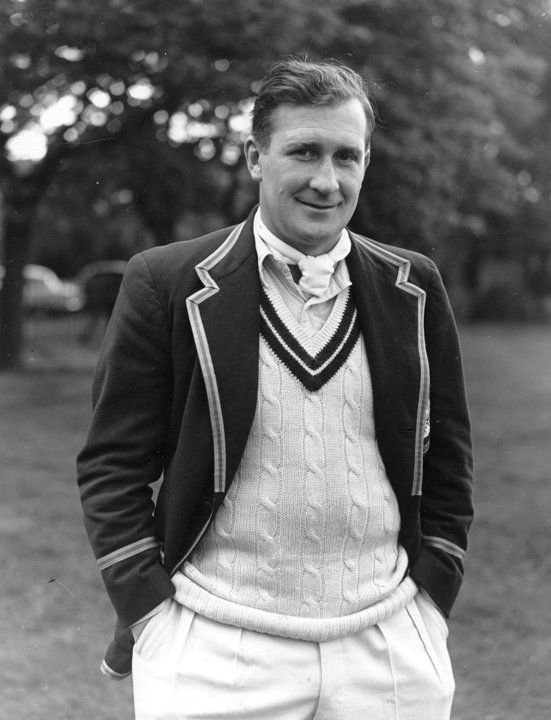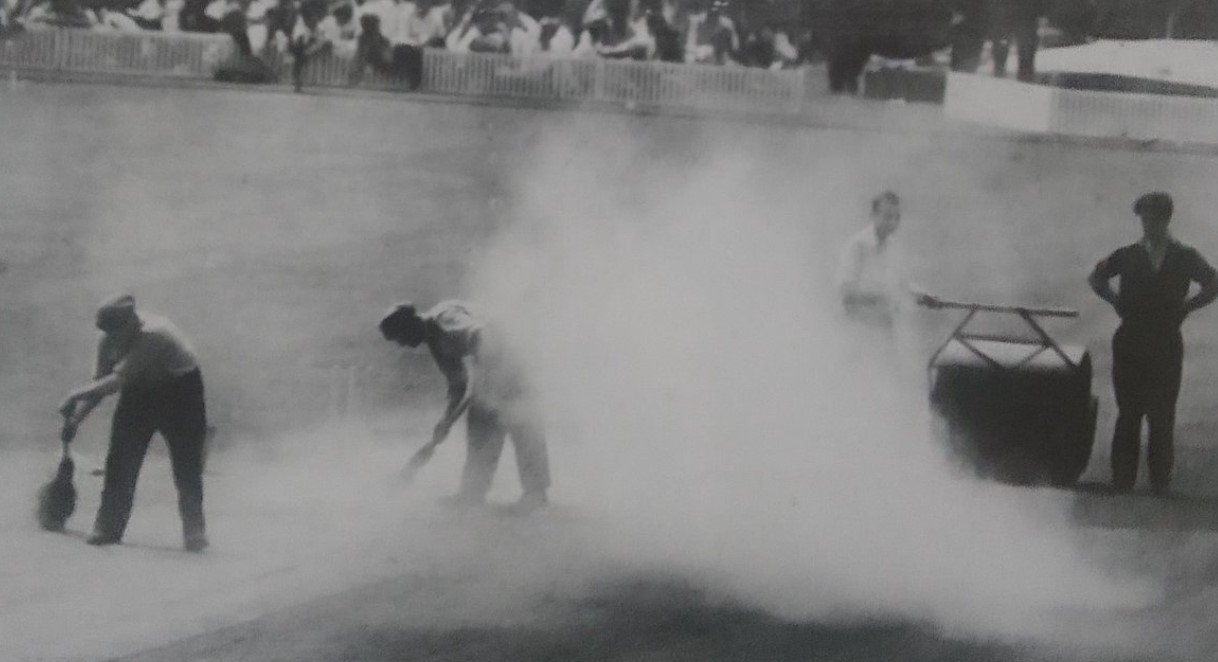Jim Laker 19 for 90 is an unsurpassable feast.
So, one such record is that of the late Jim Laker, the Surrey and England off-spinner who died more than 20 years ago. His match figures of 19 for 90 (9 for 37 and 10 for 50) in the fourth Test against Australia at Old Trafford, Manchester, in the 1956 Ashes series have been in the record books for 63 years. It is likely to remain unsurpassed for many decades to come. It is highly improbable that some super bowler will be born during the 21st century to take all ten wickets in each innings of a Test match.
Writing about Jim Laker in the 1957 Wisden, the late Sir Neville Cardus, doyen among cricket writers, has this to say. Obviously, God endowed him in his cradle with that indefinable power that, from time to time, enervates talent into abnormal and irresistible achievement. And he had done his conjurations. They have been nothing less than one of the oldest rickshaws of the bowler’s trade.
Not by the newfangled swing and not by googlies or Machiavellian deceit by fighting through the air. Jim Laker hypnotized batsmen into helpless immobility. But by off-breaks of the finger spin type, which would have been recognized and approved by cricketers. Who played in Laker’s own county, Surrey. More than half a century ago, but for the sheer technical potentiality, often for sheer actual spitefulness, Laker’s off-spin must be regarded as entirely out of the ordinary and very much his own.
It is all too well known that certain bowlers cast a spell over some batsmen whom they regard as there bunnies. Such batsmen shake in there trousers when facing there nemesis or demon bowler and, before long, gift their wicket to the dreaded bowler. It would not be an exaggeration to say that the year 1956 belonged to Jim Laker. He bowled himself to near immortality with his right arm off-spin. Seldom had any bowler reduced a bunch of batsmen to such abject surrender as did Laker, the visiting Australian that year.
Not that they were experienced or an incompetent lot in batting techniques. One could hardly call such wielders of the willow as Colin McDonald, Jim Burke, Neil Harvey, Keith Miller, Ian Craig, Ken Mackay, Richie Benaud, and Aland Davidson rabbits or inexperienced batsmen. Yet none of them hit a hundred in any of the five tests played in England that year.

Jim Laker’s figures in the 1956 rubber were 46 wickets for 442 runs at just 9.60 per wicket. In the fourth test alone, he took 19 for 90. Incredible is the only word to describe that feat. It was the sort of stuff written in boy’s fiction.
That record has stood the test for several decades and still stands to this day. Even though more than six decades have passed since it was established, Jim Laker had begun to cast his magic spell over the Aussie batsmen from the very first Test he played against them in that season. In fact, even earlier, playing for Surrey in the 3-day game against Australia at the Oval
During the middle of May that year, the off-spinner had captured all ten wickets for 88 runs in 46 overs of the first innings and 2 for 42 in the second. His Surrey colleague, left-arm spinner Tony Lock, bagged 7 for 49 to shunt the Australians for 107 runs and steer the county to a 10-wicket victory, something that had not happened during the previous decades.
Not since 1878 had any bowler taken all ten wickets in an innings against Australia on English soil. It was another Surrey bowler, Barrett, playing for the players at this very venue, who had taken all ten wickets in an innings against the visiting Australians. History had repeated itself after all those years.
Prior to that tremendous record-breaking performance at Old Trafford, Laker had given a foretaste of what the Aussies were going to get by capturing 11 for 113 (5 for 56 and 6 for 55) in the third Test at Headingley, Leeds. Jim Lake and Tony Lock had fully exposed the Australian batsmen’s weakness against the turning ball.
Subtle Difference between Lara’s and Laker Records
This record of Jim Laker’s fantastic figures of 19 for 90 at Old Trafford in a Test against Manchester will most probably remain in the Test annals for many decades of this century. And there are some pretty solid reasons for this assertion.
The subtle difference between Brian Lara’s world record innings of 400 runs and the bowling record of Jim Laker’s 19 for 90 in the two innings of a Test match must be fully appreciated. In recording the highest test score, he had ten other West Indies batsmen to help him reach that mark. So long as they kept him company at the wicket, he kept heading for that record.
However, in the case of Jim Laker, or for that matter, any bowler, the rules do not permit him to bowl from both ends continuously and alternately, and then there are at least four other recognized bowlers in a playing eleven, competing with each other, all trying hard to get wickets when called upon to turn there arm over.
There is yet another point worth serious consideration. A fast bowler or a paceman is normally never called upon to bowl a lengthy spell as a spinner is. Moreover, a batting record is more vulnerable and, as such, more likely to get broken more often than a bowling record. Sir Len Hutton set his record of 364 in 1938 at the Oval. Almost two decades passed before another cricketing knight, Sir Garfield Sobers, broke that record with 365 not out at Kingston, Jamaica.
Then, after 36 years’, Brian Lara improved on his countryman record with 375 at St. Johns, Antigua. After that, Matthew Hayden 380 crossed the landmark against Zimbabwe, and then Lara again surpassed the world record by hitting his first ever 400 not-out runs against England.
But Jim Laker’s bowling record of 19 for 90 has been in the books for 63 years. He has stood the test of time so far. It is highly improbable that it will be broken in this century. It is even more unlikely that some unplayable bowler will be born during the next half of a dozen decades. They will bamboozle all ten batsmen twice during the course of a test match. This record is worth pointing out because the feat of taking all wickets in a Test innings was performed once by Anil Kumble against Pakistan in 1999.
That brings us back to the original question. Will Jim Laker’s record of 19 for 90 in a Test match be surpassed during this century? What will your answer be? Please leave your thoughts in the comment section. Such feats are performed once in a lifetime. It looks like an impossible feat. It looks like Jim Laker made just one superb effort at Old Trafford to become immortal in the annals of the game.

Australia vs England Test Match at Manchester, 1956
-
“The ball turned on a strip that blatantly assisted spin.”
-
“All 19 Jim Laker wickets had fallen at the same end.”
-
“England ended an era for Australian cricket in emphatic style.”
-
“The time had come to rebuild Australia’s national team.”
The Significance of Cricket History
History is always in the process of being written, sometimes even rewritten. Because something is happening all the time, as time never stands still. It keeps ticking away while events are taking place. Records were established, and history is being written or rewritten. This entire series must, therefore, be reviewed from that angle. Since we happen to be standing on the threshold of the 2020 century, we are in a position to look back and, to some extent, also look ahead.
One can almost see the flow over the horizon, which heralds the beginning of the new era. Records in various fields of activity have filled the pages of history. Cricket is no exception. Volumes and volumes have been written about this game of the flanneled fools. It is said that more books have been written on cricket than any three games put together.
Considering that it has been played at the test level for over fifteen decades, It should not be surprising that so much literature is available on the subject. Plenty happens during the course of five-day tests to fill a whole chapter. Hundreds of old marks have been erased a dozen times during this century alone, and new ones have entered the annals of cricket.
Well, some records seem unsurpassable, established during the course of the past hundred and fifty years or so, and may be broken during this century. But in some cases, the chances of at least some of the existing records being broken are not very bright, of course. One can never tell in the case of an unpredictable game like cricket, with all its traditions of glorious uncertainty.
But, considering that technology will have a big say in shaping the destiny of the game, one could predict it with a reasonable degree of certainty. Certain records established during those times will take a long time to be broken and rewritten in the years to come.
So, records are made in various fields of sports, particularly cricket. Some of these marks are made and remade in quick succession. But there are some feats that remain longer in the record books and that make the scribes and pen pushers say this will take some beating and will stay in the books for a long time to come.
Read More Jim McConnon – England Right Arm Off-Spin Bowler / Ashes Memories – Mark Butcher Leads with a Dazzler
